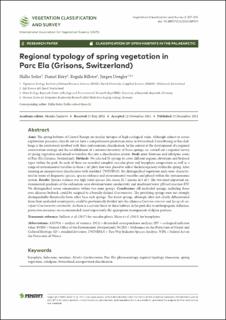Please use this identifier to cite or link to this item:
https://doi.org/10.21256/zhaw-23924Full metadata record
| DC Field | Value | Language |
|---|---|---|
| dc.contributor.author | Seiler, Hallie | - |
| dc.contributor.author | Küry, Daniel | - |
| dc.contributor.author | Billeter, Regula | - |
| dc.contributor.author | Dengler, Jürgen | - |
| dc.date.accessioned | 2022-01-14T13:35:20Z | - |
| dc.date.available | 2022-01-14T13:35:20Z | - |
| dc.date.issued | 2021-12-13 | - |
| dc.identifier.issn | 2683-0671 | de_CH |
| dc.identifier.uri | https://digitalcollection.zhaw.ch/handle/11475/23924 | - |
| dc.description.abstract | Aims: The spring habitats of Central Europe are insular biotopes of high ecological value. Although subject to severe exploitation pressures, they do not yet have a comprehensive protection status in Switzerland. Contributing to this challenge is the controversy involved with their syntaxonomic classification. In the context of the development of a regional conservation strategy and the establishment of a national inventory of Swiss springs, we carried out a regional survey of spring vegetation and aimed to translate this into a classification system. Study area: Montane and subalpine zones of Parc Ela (Grisons, Switzerland). Methods: We selected 20 springs to cover different regions, elevations and bedrock types within the park. In each of them we recorded complete vascular plant and bryophyte composition as well as a range of environmental variables in three 1-m² plots that were placed to reflect the heterogeneity within the spring. After running an unsupervised classification with modified TWINSPAN, the distinguished vegetation units were characterized in terms of diagnostic species, species richness and environmental variables and placed within the syntaxonomic system. Results: Species richness was high (total species 264, mean 21.7 species in 1 m2). The two most important environmental gradients of the ordination were elevation/water conductivity and insolation/water pH/soil reaction EIV. We distinguished seven communities within two main groups. Conclusions: All unshaded springs, including those over siliceous bedrock, could be assigned to a broadly defined Cratoneurion. The petrifying springs were not strongly distinguishable floristically from other base-rich springs. The forest springs, although often not clearly differentiated from their unshaded counterparts, could be provisionally divided into the alliances Caricion remotae and Lycopodo europaei-Cratoneurion commutati. As there is a certain threat to these habitats in the park due to anthropogenic influence, protection measures are recommended, most importantly the appropriate management of alpine pastures. | de_CH |
| dc.language.iso | en | de_CH |
| dc.publisher | Pensoft | de_CH |
| dc.relation.ispartof | Vegetation Classification and Survey | de_CH |
| dc.rights | http://creativecommons.org/licenses/by/4.0/ | de_CH |
| dc.subject | Bryophyte | de_CH |
| dc.subject | Helocrene | de_CH |
| dc.subject | Montane | de_CH |
| dc.subject | Montio-Cardaminetea | de_CH |
| dc.subject | Parc Ela | de_CH |
| dc.subject | Phytosociology | de_CH |
| dc.subject | Regional typology | de_CH |
| dc.subject | Rheocrene | de_CH |
| dc.subject | Spring vegetation | de_CH |
| dc.subject | Subalpine | de_CH |
| dc.subject | Switzerland | de_CH |
| dc.subject | Unsupervised classification | de_CH |
| dc.subject.ddc | 580: Pflanzen (Botanik) | de_CH |
| dc.title | Regional typology of spring vegetation in Parc Ela (Grisons, Switzerland) | de_CH |
| dc.type | Beitrag in wissenschaftlicher Zeitschrift | de_CH |
| dcterms.type | Text | de_CH |
| zhaw.departement | Life Sciences und Facility Management | de_CH |
| zhaw.organisationalunit | Institut für Umwelt und Natürliche Ressourcen (IUNR) | de_CH |
| dc.identifier.doi | 10.3897/VCS/2021/69101 | de_CH |
| dc.identifier.doi | 10.21256/zhaw-23924 | - |
| zhaw.funding.eu | No | de_CH |
| zhaw.originated.zhaw | Yes | de_CH |
| zhaw.pages.end | 274 | de_CH |
| zhaw.pages.start | 257 | de_CH |
| zhaw.publication.status | publishedVersion | de_CH |
| zhaw.volume | 2 | de_CH |
| zhaw.publication.review | Peer review (Publikation) | de_CH |
| zhaw.webfeed | Vegetationsökologie | de_CH |
| zhaw.author.additional | No | de_CH |
| zhaw.display.portrait | Yes | de_CH |
| zhaw.monitoring.costperiod | 2021 | de_CH |
| Appears in collections: | Publikationen Life Sciences und Facility Management | |
Files in This Item:
| File | Description | Size | Format | |
|---|---|---|---|---|
| 2021_Seiler-etal_Regional-typology-spring-vegetation-Parc-Ela_VCS.pdf | 6.5 MB | Adobe PDF |  View/Open |
Show simple item record
Seiler, H., Küry, D., Billeter, R., & Dengler, J. (2021). Regional typology of spring vegetation in Parc Ela (Grisons, Switzerland). Vegetation Classification and Survey, 2, 257–274. https://doi.org/10.3897/VCS/2021/69101
Seiler, H. et al. (2021) ‘Regional typology of spring vegetation in Parc Ela (Grisons, Switzerland)’, Vegetation Classification and Survey, 2, pp. 257–274. Available at: https://doi.org/10.3897/VCS/2021/69101.
H. Seiler, D. Küry, R. Billeter, and J. Dengler, “Regional typology of spring vegetation in Parc Ela (Grisons, Switzerland),” Vegetation Classification and Survey, vol. 2, pp. 257–274, Dec. 2021, doi: 10.3897/VCS/2021/69101.
SEILER, Hallie, Daniel KÜRY, Regula BILLETER und Jürgen DENGLER, 2021. Regional typology of spring vegetation in Parc Ela (Grisons, Switzerland). Vegetation Classification and Survey. 13 Dezember 2021. Bd. 2, S. 257–274. DOI 10.3897/VCS/2021/69101
Seiler, Hallie, Daniel Küry, Regula Billeter, and Jürgen Dengler. 2021. “Regional Typology of Spring Vegetation in Parc Ela (Grisons, Switzerland).” Vegetation Classification and Survey 2 (December): 257–74. https://doi.org/10.3897/VCS/2021/69101.
Seiler, Hallie, et al. “Regional Typology of Spring Vegetation in Parc Ela (Grisons, Switzerland).” Vegetation Classification and Survey, vol. 2, Dec. 2021, pp. 257–74, https://doi.org/10.3897/VCS/2021/69101.
Items in DSpace are protected by copyright, with all rights reserved, unless otherwise indicated.